5 Stones Artisan Brewery
Château Lynch-Bages
Grand Cru Classé Pauillac Cabernet Sauvignon Blend 2000
The 2000 is delicious but, it is evolving at a glacial pace. Out of magnum.
On the nose, touch of barnyard, glycerin, ripe; blackberries, dark cherries, black raspberries, plum, strawberries & cherries. Vanilla, dry clay, limestone, river stones, just a touch of pyrazines & bandaid, dark,,turned, moist earth, dry grass and dry & fresh dark florals.
The body is full, round & sexy. Dry softened, sweet tannins. ripe; blackberries, dark cherries, black raspberries, plum, strawberries & cherries. Vanilla, dry clay, limestone, river stones, just a touch of pyrazines & bandaid, fresh tobacco leaf, saddle-wood, dry underbrush, dark, turned, moist earth, dry grass and dry & fresh dark florals. The acidity is magnificent. The structure, tension, length and balance are sensational. The finish is drop dead gorgeous. I’d still hold mine another 5 years as long as you have 3-4 bottles for more 5 year increments.
Photos of, their Estate vines, Clyde Beffa-Owner of K&L Wine Merchants, Owner of Chateau Lynch Bages - Jean-Michel Cazes, guests of the dinner and a sunset view from their Estate.
Producer notes and history...Lynch Bages takes its name from the local area where the Chateau is located in Bages. The vineyard of what was to become Lynch Bages was established and then expanded by the Dejean family who sold it in 1728 to Pierre Drouillard.
In 1749, Drouillard bequeathed the estate to his daughter Elizabeth, the wife of Thomas Lynch. This is how the estate came to belong to the Lynch family, where it remained for seventy-five years and received the name Lynch Bages. However, it was not always known under that name.
For a while the wines were sold under the name of Jurine Bages. In fact, when the estate was Classified in the 1855 Classification of the Medoc, the wines were selling under the name of Chateau Jurine Bages. That is because the property was owned at the time by a Swiss wine merchant, Sebastien Jurine.
In 1862, the property was sold to the Cayrou brothers who restored the estate’s name to Chateau Lynch family.
Around 1870, Lou Janou Cazes and his wife Angelique were living in Pauillac, close to Chateau Pichon Longueville Baron. It was here that Jean-Charles Cazes, the couple’s second son, was born in 1877.
In the 1930’s, Jean-Charles Cazes, who was already in charge of Les-Ormes-de-Pez in St. Estephe agreed to lease the vines of Lynch Bages. By that time, the Cazes family had history in Bordeaux dating back to the second half of the nineteenth century.
This agreement to take over Lynch Bages was good for both the owner and Jean Charles Cazes. Because, the vineyards had become dilapidated and were in need of expensive replanting, which was too expensive for the owner. However, for Cazes, this represented an opportunity, as he had the time, and the ability to manage Lynch Bages, but he lacked the funds to buy the vineyard.
Jean-Charles Cazes eventually purchased both properties on the eve of the Second World War. Lynch Bages and Les-Ormes-de-Pez have been run by the Cazes family ever since. In 1988, the Cazes family added to their holdings in Bordeaux when they purchased an estate in the Graves region, Chateau Villa Bel Air.
Around 1970, they increased their vineyards with the purchase of Haut-Bages Averous and Saussus. By the late 1990’s their holdings had expanded to nearly 100 hectares! Jean-Michel Cazes who had been employed as an engineer in Paris, joined the wine trade in 1973. In a short time, Jean Michel Cazes modernized everything at Lynch Bages.
He installed a new vat room, insulated the buildings, developing new technologies and equipment, built storage cellars, restored the loading areas and wine storehouses over the next fifteen years. During that time period, Jean Michel Cazes was the unofficial ambassador of not just the Left Bank, but all of Bordeaux. Jean Michel Cazes was one of the first Chateau owners to begin promoting their wine in China back in 1986.
Bages became the first wine sent into space, when a French astronaut carried a bottle of 1975 Lynch Bages with him on the joint American/French space flight!
Beginning in 1987, Jean-Michel Cazes joined the team at the insurance company AXA, who wanted to build an investment portfolio of quality vineyards in the Medoc, Pomerol, Sauternes, Portugal and Hungary.
Jean-Michel Cazes was named the director of the wine division and all the estates including of course, the neighboring, Second Growth, Chateau Pichon Baron.
June 1989 marked the inauguration of the new wine making facilities at Lynch Bages, which was on of their best vintages. 1989 also marked the debut of the Cordeillan- hotel and restaurant where Sofia and I had one of our best dinners ever. A few years after that, the Village de Bages with its shops was born.
The following year, in 1990, the estate began making white wine, Blanc de Lynch Bages. In 2001, the Cazes family company bought vineyards in the Rhone Valley in the Languedoc appellation, as well as in Australia and Portugal. They added to their holdings a few years later when they purchased a vineyard in Chateauneuf du Pape.
In 2006, Jean-Charles Cazes took over as the managing director of Chateau Lynch Bages. Jean-Michel Cazes continues to lead the wine and tourism division of the family’s activities. Due to their constant promotion in the Asian market, Chateau Lynch Bages remains one of the strongest brands in the Asian market, especially in China.
In 2017, Chateau Lynch Bages began a massive renovation and modernization, focusing on their wine making, and technical facilities. The project, headed by the noted architects Chien Chung Pei and Li Chung Pei, the sons of the famous architect that designed the glass pyramid for the Louvre in Paris as well as several other important buildings.
The project will be completed in 2019. This includes a new grape, reception center, gravity flow wine cellar and the vat rooms, which will house at least, 80 stainless steel vats in various sizes allowing for parcel by parcel vinification.
The new cellars will feature a glass roof, terraces with 360 degree views and completely modernized reception areas and offices. They are not seeing visitors until it’s completion.
In March, 2017, they purchased Chateau Haut Batailley from Françoise Des Brest Borie giving the Cazes family over 120 hectares of vines in Pauillac!
The 100 hectare vineyard of Lynch Bages is planted to 75% Cabernet Sauvignon, 17% Merlot, 6% Cabernet Franc and 2% Petit Verdot. The vineyard has a terroir of gravel, chalk and sand soils.
The vineyard can be divided into two main sections, with a large portion of the vines being planted close to the Chateau on the Bages plateau. At their peak, the vineyard reaches an elevation of 20 meters. The other section of the vineyard lies further north, with its key terroir placed on the Monferan plateau.
They also own vines in the far southwest of the appellation, next Chateau Pichon Lalande, on the St. Julien border, which can be used in the Grand Vin. The vineyard can be split into four main blocks, which can be further subdivided into 140 separate parcels.
The average age of the vines is about 30 years old. But they have old vines, some of which are close to 90 years old.
The vineyards are planted to a vine density of 9,000 vines per hectare. The average age of the vines is about 30 years old. But they have old vines, some of which are close to 90 years old.
Lynch Bages also six hectares of vine are reserved for the production of the white Bordeaux wine of Chateau Lynch Bages. Those vines are located to the west of the estate. They are planted to 53% Sauvignon Blanc, 32% Semillon and 15% Muscadelle. On average, those vines are about 20 years of age. Lynch Bages Blanc made its debut in 1990.
To produce the wine of Chateau Lynch Bages, vinification takes place 35 stainless steel vats that vary in size. Malolactic fermentation takes place in a combination of 30% French, oak barrels with the remainder taking place in tank.
The wine of Chateau Lynch Bages is aged in an average of 70% new, French oak barrels for between 12 and 15 months. Due to the appellation laws of Pauillac, the wine is sold as a generic AOC Bordeaux Blanc, because Pauillac does not allow for the plantings of white wine grapes.
For the vinification of their white, Bordeaux wine, Blanc de Lynch-Bages is vinified in a combination of 50% new, French oak barrels, 20% in one year old barrels and the remaining 30% is vinified in vats. The wine is aged on its lees for at least six months. The white wine is sold an AOC Bordeaux wine.
The annual production at Lynch Bages is close to 35,000 cases depending on the vintage.
The also make a 2nd wine, which was previously known as Chateau Chateau Haut Bages Averous. However, the estate changed its name to Echo de Lynch Bages beginning with the 2007 vintage. The estate recently added a third wine, Pauillac de Lynch-Bages.
— 6 years ago


Morlet Family Vineyards
Mon Chevalier Cabernet Sauvignon 2009
On the nose; ripe, powerful, blackberries, spiced black plum, dark liqueured cherries, baked strawberries, mocha chocolate, dark chocolate, cinnamon, clove, vanilla, haunting blue fruits, river stones, crushed rocks, chocolate pudding, spice-box, fresh tobacco leaf, graphite, violet and fresh dark floral bouquet. The palate is just starting to nicely resolve. It’s thick, rich and powerful with dusty tannins. Dark currants, blackberries, dark cherries, black raspberries, black plum, baked strawberries, boysenberries, blue fruits that come & go, mocha, dark chocolate, caramel, vanilla, nutmeg, clove, cinnamon stick, chocolate pudding, spice-box, graphite, fresh tobacco leaf, dark dry earth, stones, crushed rocks, dry herbs, spearmint, underbrush, violets & fresh dark florals, round acidity, big structure, long length, perfect tension, long, round, rich and very elegant long beautifully polished finish. It’s in its first year of good drinking with another 15 years plus of good drinking ahead. It has the potential for 2-3 more points with 5-8 more years in the bottle. Photos of their property and Owner/Winemaker Luc Morlet. — 7 years ago
Von Schubert
Maximin Grünhauser Abtsberg Spätlese Riesling 2015
Light golden color. Aroma of apples, apricots, and stones. Fantastic acid. This will age and be better in 5-8 years. — 7 years ago
Château Haut-Bergey
Pessac-Léognan Red Bordeaux Blend 1998
A glass of wine to finish up the night...good age, nice evolution and an extremely good value at $25. Recent direct Chateau purchase. While the 1998 Bordeaux vintage was panned by the critics as a whole on the Left Bank, Pessac-Leognan shined better than most on the Left Bank. It was Right Bank Saint Emilion that had the great year. This 98 Haut-Bergey is not quite the wine the 98 Haut-Bailly is. However, it is delicious for $25. Nose of; blackberries, dark cherries, cherries, strawberries leather, cedar, tobacco leaf, dry stones, vanilla, dark moist soils and fresh red florals. The body is medium to lean. Tannins are completely resolved. Ripe, lean, shining; blackberries, dark cherries, strawberries & cherries. Black moist earth, touch of funk, soft chewy leather, stones, crushed dry rock powder, cedar, tobacco leaf, steeped fruit tea, cola, dry underbrush, fresh & dry red florals, liquid violets with raining acidity. The finish has lean, bright mid red fruits, earth and dark spices. Nice wine for the $. While this will hold another 3-5 years, it's not going to continue to improve. So, drink em. Photos of; the Chateau, barrel room, view inside the Chateau and their shiny stainless steel fermentation tanks. — 7 years ago
Château Pichon-Longueville Baron
Baron de Pichon-Longueville Pauillac Red Bordeaux Blend 2003
This is the most picturesque Chateau in Bordeaux. Oh...and they make a pretty amazing Bordeaux. It's a good first look at the 03 vintage from my five bottle set. There are steak wines and then there are steak wines. This was a 10 pair with the T-bone...Heaven. The tannins have softened but have many years ahead to get to that perfect place. The mouthfeel is full, round, creamy and elegant. The fruits have a not too sweet liqueur style. They are; blackberries, dark cherries, black plum, black raspberries, plum, sweet tobacco leaf, anise, used leather, black tea, used coffee grounds, rich wet black turned earth, stones, dry red florals, spice; clove, nutmeg, baking spices; very light vanilla, touch of caramel, dark chocolate and acidity that pours over the palate. There is the start of harmony in the structure, length, balance and tension. The finish lasts a full two-minutes and it crushed with the T-bone. Next bottle in 5-7 years. For the legions of you on Delectable crushing only young Napa Cabernet, you have no idea what you're missing in aged Bordeaux...forget about it...even vs. well aged Napa Cabernet. Respect!!! 3-4 hour decant and it needed every second of it. — 8 years ago
Joseph Phelps Vineyards
Backus Vineyard Cabernet Sauvignon 2003
Dark...nearly black cassis. Blackberries, black liqueur plum, black cherries, black raspberries, creamed raspberries and pouched strawberries on the back palate, black licorice anise(the deep core of it), graphite, lead pencil shavings, menthol, herbs, spice-box, soft leather, rich black sweet earth, chocolate cake w/ dark raspberries, wet stones, dry brush, dry florals & fresh violets, light baking spices, vanilla and long rich, full, thick, candied, dark cassis finish that lasts over a minute. It has nice balance, acidity, length and a very polished finish. This will continue to get better over the next 10-15 years. Good now but will revisit in another 5-7 years. @Jory — 8 years ago

Benjamin Leroux
Gevrey-Chambertin Pinot Noir 2010
Tart & sour cherries, raspberries, touch of plum, forest floor, lots of chalk, stones and good acidity. Beautiful soft tannins round out the long, smooth and elegant finish. I'd wait and 5 years to open another bottle. — 9 years ago
Artisan 5
Masterpiece Cabernet Sauvignon Blend 2012
Lovely artisan wine with deep blackberry notes and few tannins. — 9 years ago
Quinta de Couselo
Rosal Rías Baixas Albariño Blend
90 Albariño, 5 Caino, 5 Loureiro; Rosal is a tiny appellation situated right where the Mino River empties into the Atlantic Ocean. Intensely saline, almost iodized. Densely textured, with powerful aromas/flavors of wet stones, sea spray, ripe citrus. Tiny bit of trapped CO2 + bracing (and appropriate) acidity. #rosal #ríasbaixas #couselo — 6 years ago
Stag's Leap Wine Cellars
Cask 23 Napa Valley Estate Cabernet Sauvignon 2010
On the nose, French roast coffee, dark currants, dark cherries, Kirsch cherries, blackberries, black raspberries, cherry cola with liqueur notes, blueberry hues, vanillin, cinnamon stick, light clove, toast, rich, dark soil, limestone minerals, sweet tarry notes, soft leather, hint of mint/eucalyptus, light graphite with bright red & dark florals.
The body is round, ripe and full. The tannins are nice rounded. The length, structure, tension and balance are coming into their own. Upon first pour, lots of French roast coffee, dark currants, dark cherries, Kirsch cherries, blackberries, black raspberries, strawberries, cherry cola with liqueur notes, blueberry hues, vanillin, cinnamon stick, light clove, cocoa powder, dark spice with just a touch of lifting heat, toast, rich, dark soil, dry stems, good presence of dry herbal notes (sage), limestone minerals, sweet tarry notes, soft leather, hint of mint/eucalyptus, light graphite with bright red & dark florals. The acidity is about as good as it gets. The finish is rich, ripe, well balance, very elegant as it opens and last several minutes.
While this is delicious tonight, it’s early on this wine. Give it another 5 and will cellar another 15 years plus.
Photos of, the newer Stag’s Leap Winery with the rock wall...all the stones used in the wall collected from the vineyards prior to planting. The cellar pendulum ball that never stops its motion once started, the newer tasting room and the twilight view from their tasting room.
— 6 years ago
Donkey & Goat
Stone Crusher Skin Ferment El Dorado Roussanne 2015
JL tasting 5/8/18. ABV 12.2. $29. Slightly cloudy medium color with orange color. Nose that's oily and flowery. Palate that's mouth coating and finish that's consistent. Stones with oil. Says pairing with scallops. — 7 years ago
Two Vintners
Some Days are Stones Syrah 2012
Ah, the Rocks at Milton-Freewater produce such remarkable and distinctive fruit. Morgan Lee’s take on the Stoney Vine Syrah is outstanding. Earthy, gamey, succulent, dark and full stone fruit (plum) that just keeps going. This is good for another 5 years I think. — 7 years ago
Jolly Pumpkin Artisan Ales
Bam Bière Bottle Conditioned Farmhouse Ale 2013
Batch 49
Bottles 5/02/2013
Drank like a week ago.
Good makes me want to know more about beer — 7 years ago
Château Brane-Cantenac
Grand Cru Classé en 1855 Margaux Red Bordeaux Blend 2005
I have a six-pack of this 05. I thought after 10 years in bottle, it would be interesting to check in on its evolution. While tasty, I’ll wait another 8-10 to open another. Even after 2-3 hours in the decanter, it’s still a very young adolescent. On the nose, slightly sour blackberries & dark cherries, dark currants, baked black plum, haunting blue fruits, anise, whiff of spice, steeped tea, dry stones, dry crushed rocks with dry top soil, caramel, vanilla with fresh & dry red florals. The body is thick & full. Tannins are starting to round out. It’s velvety on the palate. The fruits are; bright, fresh & ripe and really show the greatness of the 05 vintage. Dark currants, blackberries, dark cherries, baked black plum, haunting blue fruits, baked strawberries, cherries, raspberries on the long set, dark spice, clay & loamy dry top soil with crushed rocks, dry stones, cigar with ash, graphite, dry stems, slight herbaceous character, mint, used leather, clove, caramel, vanilla, fresh & dry red florals with violets. The round acidity is about perfect. The structure and length are still strong. The balance is in harmony. As for the long finish, it’s lush, ruby, rich and well polished. Photos of; Chateau Brane Cantenac, large wood vats, Henri Lurton and Estate vines. Producer notes and history...Chateau Brane Cantenac began in the early 17th century. At the time, the estate was known as Domaine Guilhem Hosten. Even that far back, wine was produced from the property. In fact, the wine was so highly regarded it was one of the more expensive wines in Bordeaux. It sold for almost as much money as Brane Mouton. This is interesting because of who went on to buy the vineyard in the 1800’s. The Baron of Brane, also known as “Napoleon of the Vineyards”, purchased the Chateau in 1833. At the time of the sale, the estate was called Chateau Gorce-Guy. To get the funds needed to purchase the Margaux vineyard, the Baron sold what is now called Mouton Rothschild, which was at the time of the sale, known as Chateau Brane-Mouton. Not such a good move with hundreds of years in hindsight! In 1838, the Baron renamed property taking his name and the name of the sector where the vineyards were located and called it Chateau Brane Cantenac. The Chateau later passed to the Roy family, who were well-known in the Margaux appellation in those days, as they owned Chateau d’issan. Moving ahead to 1920, the Societe des Grands Crus de France, a group of merchants and growers that owned several chateaux located in the Medoc including; Chateau Margaux, Chateau Giscours, and Chateau Lagrange in St. Julien, purchased Chateau Brane Cantenac. Five years later, M. Recapet and his son-in-law, François Lurton, took over Brane Cantenac along with Chateau Margaux. Lucien Lurton (the son of François Lurton) inherited Brane Cantenac in 1956. Today, the estate is still in the hands of the Lurton family. Brane Cantenac is owned and run by Henri Lurton. After being given the responsibility of managing Brane Cantenac, it was under the direction of Henri Lurton that large portions of the vineyard were replanted. Vine densities were increased, the drainage systems were improved and the plantings were also, slowly changed. The vineyard of Brane Cantenac is planted to 55% Cabernet Sauvignon, 40% Merlot, 4.5% Cabernet Franc and .5% Carmenere. Carmenere was used for the first time in the 2011 vintage. The only other Chateau I know that still uses Carmenere is Clerc Milon. The 75 hectare Left Bank vineyard of Brane Cantenac is essentially unchanged since it earned Second Growth status in the 1855 Classification. At least that is the case with the 45 hectares used to produce the Grand Vin of Brane Cantenac. Those 45 hectares are planted surrounding the Chateau. Those vines are located just in front of the Cantenac plateau and are the best terroir that Brane Cantenac owns. They have other parcels, which are further inland and much of those grapes are placed into their second wine, Le Baron de Brane. Those additional hectares can be divided into 3 main sections. Behind the Chateau, they have 15 hectares of vines on gravel and sand, 10 hectares across the road with sand, gravel and iron and a 13 hectare parcel with gravel called Notton, which is used for their second wine. The vineyard is planted to a vine density that ranges from 6,666 vines per hectare on the plateau and up to 8,000 vines per hectare for the vines located behind chateau, in their sandier soils. The higher levels of vine density are always found in the newer plantings. The terroir of Brane Cantenac consists of deep gravel, sand and clay soil. Experiments in the vineyards are currently looking at becoming more organic in their vineyard management. Today, more than 25% of Brane Cantenac is farmed using organic farming techniques. It is expected that over time, the amount of hectares farmed with organic methods will be increased. Brane Cantenac has gone through 2 relatively recent modernization’s in 1999, when they added began adding the first of their smaller vats to allow for parcel by parcel vinification and then again in 2015 when they completed a much more complete renovation of their cellars and vat rooms. While Brane Cantenac is a traditional producer, they are no stranger to technology as they were one of the first estates to embrace optical grape sorting machines. In very wet vintages, they can also use reverse osmosis. To produce the wine of Chateau Brane Cantenac, the wine is vinified in a combination of temperature controlled, traditional, 22 oak vats, 18 concrete tanks and 20 stainless steel vats that vary in size from 40 hectoliters all the way up to 200 hectoliters, which allows for parcel by parcel vinification. 40% of the fermentation takes place in the oak vats. The oldest vines are vinified in vats that are selected to allow for separate parcel by parcel vinification. The younger vines are vinified more often together in the same vats. However, the Carmenere is entirely micro-vinified, meaning that those grapes were completely vinified in barrel, using micro-vinification techniques. This can also happen because the amount of grapes produced is so small. Some vats can be co-inoculated, meaning they go through alcoholic fermentation and malolactic fermentation simultaneously. At Chateau Brane Cantenac, malolactic fermentation takes place in a combination of French oak tanks and barrels. The wine of Brane Cantenac is aged in an average of 60% new, French oak barrels for 18 months before bottling. The initial 2 months of aging is done with the wine on its lees, which adds more depth to the wine. There second wine is Le Baron de Brane. Le Baron de Brane is not new. In fact, previously, the second wine went under the name of Chateau Notton, which took its name from one of the main parcels where the grapes were planted. During the late 1950’s and into the 1960’s, having a second wine was important as the estate declassified 3 vintages, due to extremely poor, weather conditions in 1956, 1960 and 1963. Production of Chateau Brane Cantenac is about 11,000 cases per year. — 7 years ago

Château Palmer
Margaux Red Bordeaux Blend 1991
In every difficult vintage, anywhere, you will find producers that make exceptional wines. This 91 Palmer is such a wine. I have to thank Clyde Beffa owner of K&L Wine Merchants who has been traveling to Bordeaux for 35+ years for highly recommending two 91 Bordeaux's to me. The 91 Pichon Lalande; which he described as "heavenly." It's just the word I would have used to described it 5 or 6 years ago. Also, this 91 Palmer. He described as, "I love it-soft and silky." I would strongly agree. You see, critics gave the 91 vintage a horrific review as a whole. Bordeaux had two frosts in April and a cold growing season. These elements didn't prevent either of these producers from making beautifully elegant 1991 wines. I have said it many times and will say it again, taste wines even in difficult vintages. You'll find value and some excellent wines. As for this 91, it's in perfect form. Excellent on it's own and even better with the ribeye. It's so elegant, smooth, beautiful, ripe and well balanced with earth & fruit. The fruits are slightly stewed & baked. Blackberries, dark cherries, black plum, black raspberries, touch of rhubarb, cherries, strawberries. Dried florals, used leather, tobacco with ash, slight vegetal quality, anise, not too sweet black cherry licorice/cola, figs, dark earth with crushed rocks, dry stones, underbrush, understated spice and perfect acidity that drips over the palate. The length, structure, balance and finish are in perfect harmony & the finish goes on and on and on. As many times as we've been to Bordeaux, we never get tired of the drive on the D-2 through Margaux and Pauillac. Chateau Margaux & Palmer stand side by side in beautiful prodigious history to say nothing of Baron Pichon & Pichon Lalande. Every year, for my B-day, I have a great steak and an old Bordeaux. It just doesn't get any better than that. And as many of those nights I've had, B-day or not, this might have been the best. Perhaps topping or equaling the Ribcap at Bourbon Steak and the 91 Pichon Lalande. To quote Gary Westby, "it steak and claret night." 12% alcohol is so much more enjoyable than 15% plus. ❤🍷🎉🎂 — 8 years ago

Jolly Pumpkin Artisan Ales
La Parcela No. 1 Pumpkin Ale 2011
5 years in and - — 8 years ago
Domaine William Fèvre
Champs Royaux Chablis Chardonnay 2014
Minerals and stones. Good balance and finish. Good Chablis value for $19. Tasted 2013 but 14 for sale. JL tasting 5/25/16 — 8 years ago
Domaine François Raveneau
Chapelot Chablis 1er Cru Chardonnay 1989
5-Oh Bday Dinner... Med yellow gold color. Honeyed citrus nose with that soil notes that says aged Raveneau. River stones, lemon, apple, and white flower in the mouth. Long finish. Great bottle. Still young. — 9 years ago
Különleges Minõségü Édes Bor
Tokaji Aszú 5 Puttonyos Furmint Blend 2008
Peach. Lilly's. Lavender. Stones. — 9 years ago
Domaine Auguste Clape
Cornas Syrah 2009
Auguste Clape was a pioneer in Cornas and a legend in the Northern Rhône. Enjoying this bottle in his memory. I was fortunate to visit the cellar twice and receive an incredibly warm welcome from the family.
The 2009 is dynamite. It is more open than I expected. Nose is vibrant with green and white peppercorn, smoked meats, allspice and road tar wrapped around dark plum, cassis and blackberry fruit. Palate is rich and dense as expected from a hot vintage. Black fruit mingles with spice, warm stones and soy flavors. Intense and long in the juicy fruit driven finish. While it can be enjoyed currently, I suggest 3 to 5 more years in a cool cellar.
Happy to move 8 cases of wine to get to this beauty. — 6 years ago
Château Lafite Rothschild
Carruades de Lafite Pauillac Red Bordeaux Blend 2003
On the nose, ripe; blackberries, sweet & sour dark cherries, cooked cherries & strawberries & hues of blueberries. Black tea, cola, soft baking spices; vanilla, light clove & cinnamon. Crushed rocks, stones, limestone, turned, moist black earth, tobacco leaf, saddle-wood, soft leather, dry & fresh dark red florals.
The body is medium edging toward full. The tannins pretty well resolved. The ripe fruits show the hot, ripe vintage. Blackberries, sweet & sour dark cherries, cooked cherries & strawberries & hues of blueberries black tea, cola, soft baking spices; vanilla, light clove & cinnamon. Crushed rocks, stones, limestone, tobacco with ash, some graphite, soft medium dark spice, turned, forest floor, powdery but edgy minerals, saddle-wood, soft leather, dry & fresh dark red florals with some violets on the finish.
This showed better with Ribeye. The Ribeye brought out a fuller, richer wine with even more complexity. 9.35-9.4 with the Ribeye. It just missed 9.2 on its own. It’s big brother the 03 “Lafite” is 💯 point Parker wine.
Photos of; Chateau Lafite, their oak vat fermenters, Estate wine and their magnificent barrel room.
Interesting history and producers notes...Lafite Rothschild has a long and interesting history dating back to 1234, even though the property was not in the Bordeaux wine business at that time.
It is has been largely believed that vines were already planted on their terroir. The owner of the estate at the time, Gombaud de Lafite left his mark, his name. Almost 1,000 years after he owned it, the Chateau is still named after him! The vines were probably in existence at Lafite for over a century, it was not until around 1680, the majority of vineyards of what we know of as Lafite Rothschild today were created. This is because on the 1680 estate manifest, there are six mentions of their Bordeaux vineyards. Jacques de Segur, earns credit for cultivating the vineyard as I wrote in my Colon Segur post last weekend. In 1695, Alexandre de Segur married Marie-Therese de Clauzel, heiress to Chateau Latour. So to dovetail that write up, within a generation, the Segur family married into two of the greatest Bordeaux vineyards, Chateau Lafite and Chateau Latour! When their son, Nicolas-Alexandre passed away, Chateau Lafite and Chateau Latour were separated.
In 1797, Chateau Lafite was sold again. In the deed of sale, Chateau Lafite was described as a Premier Cru of Medoc. This is one of the earliest mentions of what we know of today as Lafite Rothschild producing wines of what would later be classified as an 1855 First Growth.
At that time, of Lafite were managed by the Goudal family. The Goudal family were wine historians and were able to read accurate records and details of the viticulture and marketing plans for Chateau Lafite in the estates formative years. The Goudal family gets the credit for creating the cellar and saving many of the oldest bottles that remain in the cold, dark cellars, including their oldest bottle, the 1797 Lafite!
The start of the famous Rothschild family begins in 1744, with the birth of Amschel Meyer. Amschel Meyer began creating his fortune while working as a merchant at “Zum Roten Schild,” which eventually became the family name of Rothschild.
In 1798 his sons were sent to various cities to create their fortunes. Needless to say, his sons all prospered as did their children in turn. This eventually led to them wanting to own a Chateau in Bordeaux. So in 1853, Baron Nathaniel de Rothschild, an English member of the Rothschild family, purchased Chateau Brane-Mouton. As was the custom of the day, the new owner renamed it using his name and Chateau Mouton Rothschild was born.
This was followed in 1868, when James Rothschild, another member of the family purchased Chateau Lafite, which was now a coveted First Growth.
On 8 August, 1868, Baron James d’Rothschild purchased Chateau Lafite, which was sold at a public auction in Paris. It’s assumed, he bought the property for family competitive reasons looking to one up his brother, the owner of Mouton Rothschild. At that time, Mouton Rothschild was only a Second Growth at the time. But, that does not paint the entire picture. The 1855 Classification had not taken on the importance associated with it the we see it today. Plus, buying Lafite was a reasonable investment as the vineyard sold for about 8 times its earning potential.
The actual Chateau is one of the older structures in Bordeaux, as part of the building dates back to the later part of the 16th century. In 1868, the vineyard took up 135 hectares, of which 74 hectares were cultivated with vines. Production was much smaller in those days than it is today as it was between 4,000 and 5,000 cases.
Just three months after the purchase, Baron James d’Rothschild passed away and Chateau Lafite Rothschild became the joint property of his three sons; Alphonse Rothschild, Gustave Rothschild & Edmond Rothschild. Since 1868, Chateau Lafite Rothschild has remained in the hands of the of Rothschild family. The new owners renamed the estate Chateau Lafite Rothschild.
Jumping ahead to the modern age, in 1962, the Rothschild family added to their holdings when they purchased Chateau Duhart-Milon, a Fourth Growth vineyard also located in Pauillac. It was owned by the Casteja family for more than a century, Chateau Duhart Milon suffered from neglect and was in a awful condition. By the time Duhart Milon was obtained by the Rothschild family, the vineyard was down to only 17 hectare which required extensive renovations.
Baron Eric Rothschild, nephew of Baron Elie Rothschild, took over the management of Lafite Rothschild in 1974. Baron Eric Rothschild was part of the fifth Rothschild generation to inherit Chateau Lafite Rothschild. In 1984, the Rothschild family added to their holdings in Bordeaux with the purchase of Chateau Rieussec in Sauternes.
1987 was a difficult vintage, but because that was the year Lafite celebrated the inauguration of their wine new cellar, they had a lot to be excited about.
The new cellars were built under the supervision of Catalan architect Ricartdo Bofill, is both underground and circular, with a vault supported by 16 columns, giving the structure a majestic architectural style. The cellar holds 2,200 barrels, which is about 55,000 cases of wine. The construction took two years to finish and was completed in 1988.
Domaines Baron Rothschild became one of the first Bordeaux properties to invest in South America when they purchased Vina Los Vascos from a Chilean family. The owners of Lafite Rothschild continued expanding their holdings with the purchase of Chateau lEvangile in Pomerol from the Ducasse family, who owned the property for almost 100 years.
The wine making at Chateau Lafite Rothschild was managed by Charles Chevallier, who began his position in 1994. Charles Chevallier was replaced by Eric Kohler in January 2016. 2017 saw another change at the estate when Jean Guillaume Prats replaced Christopher Salin as the President of Domaines Baron Rothschild.
Perhaps, it’s the most refined of the First Growth. The wine, like all First Growth’s takes decades to mature. It has remarkable staying powers. Bottles of 1870 Lafite Rothschild discovered in the Glamis castle remain profound at more than 140 years of age! It is consider by many Master Sommeliers to be the best wine in the world.
Chateau Lafite Rothschild is one of the earliest major Bordeaux estates to bottle their own wine. In 1890, they bottled a large portion of the wine and again in 1906. Part of the estate bottling was due to requests from Negociants who were willing to pay more for Chateau bottled wines. Also, bottling was primarily done to combat piracy. At the time, it was known that merchants in some countries, like Russia were bottling cheap wine and placing labels from Lafite Rothschild on the bottles. The Koch’s famous Jefferson bottles were not the first attempt at counterfeiting.
Prior to 1996, some would say the property had its share of ups and downs. The 1960’s and 1970’s were not great for Chateau Lafite Rothschild. But since 1996, Lafite Rothschild has been producing some of the best wine in their history!
Sadly, only the wealthy can afford to purchase it. Price aside, there is no denying the level of quality. In 2003 Lafite Rothschild produced a wine that is possibly unequaled by the estate at any time in their long history. Hence, my purchase of their 03 second wine. 2009, 2010 and 2016 are not far behind.
Starting in about 2008, Lafite Rothschild became the most collectible wine from Bordeaux. Prices exploded due to demand from China as Chinese businessmen bought them as gifts or bribes depending on you look at it.
The reason this started was Lafite Rothschild paid for product placement on the number one rated Chinese soap opera on television. Characters in that show were pictured enjoying life with Lafite Rothschild and since then demand went through the roof as did priced.
However, Issac Newton had it right when he declared “What goes up, must come down.” Prices for Lafite Rothschild plummeted after 2011. By the difficult 2013, prices were finally starting to hold firm, but many of the vintages that were setting price records on a daily basis had lost close to 50% of their value.
Starting with the 2012 vintage, Chateau Lafite Rothschild began instituting anti-counterfeiting measures. From 2012 forward, to help fight, rampant counterfeiting, the estate places a seal of authenticity on the capsules of both Lafite Rothschild and Carruades de Lafite. The seal features a unique, numbered code that can be checked on their website, to verify if the wine is real.
The 112 hectare vineyard of Chateau Lafite Rothschild is planted to 70% Cabernet Sauvignon, 25% Merlot, 3% Cabernet Franc and 2% Petit Verdot. This shows a slight change in the vineyard.
While Cabernet Sauvignon remained at 70%, today there is slightly more Merlot, less Cabernet Franc and the Petit Verdot has been added since the mid 1990’s.
Located in the far north of the Pauillac appellation, only the small, Jalle de Breuil stream separates the vineyards from St. Estephe. You could divide the vineyards of Chateau Lafite Rothschild into three sections with 100 separate parcels in all. The estate has close to 50 hectares of vines located close to the Chateau, on both sides of the D2, which offers gentle rises in elevations of up to 27 meters. They also have about 50 hectares vines planted on the plateau in the Carruades sector, where they have two blocks of vines, one of which is inside the vineyard of Chateau Mouton Rothschild. It is interesting to note that even though the parcels in the Carruades sector give their name to the second wine of the estate, those vines are almost always placed in the Grand Vin.
There are also vines adjacent to, and interspersed with the vineyards of Chateau Duhart Milon. The property also consists of a smaller, 4.5 hectare parcel of vines located in the Saint Estephe appellation, “La Caillava”. The vines in St. Estephe are situated not that far from Cos d Estournel, which are located on a larger a parcel known as Blanquet. The vines in Saint Estephe are allowed to be placed into the wine of Chateau Lafite Rothschild because those vines were used to produce Lafite in 1885, at the time of the classification. The vineyards are close to their famous neighbor Mouton Rothschild.
Located just south of the Chateau, the best terroir of Lafite Rothschild has a thick layer of gravel with sand, clay, marl and limestone in the soils with rolling, gravel slopes. The gravel can be as deep as 4 meters in some parcels.
It is important to note that even though their vineyards are in the far north of Pauillac, most of the soil is pure gravel, rocks and stones. With more than 50% of the soil consisting of gravel, that is a large part of the reason Lafite Rothschild has such elegant, feminine textures and that coveted sensation of minerality.
On average, the vines are close to 40 years of age. However, Chateau Lafite Rothschild has much older vines. In fact, they have some vines that are more than 100 years of age planted in the La Graviere section. That small parcel of Merlot vines dates back to 1886. Less than 1% of the vines are that old.
Additionally, they have a small section of Cabernet Sauvignon that dates back to 1922! Other old vines range from 50 to 90 years of age! They also maintain some of the oldest Petit Verdot vines in the Medoc that was planted in the early 1930’s.
At Chateau Lafite Rothschild, between 1% to 1.5% of the vineyard is replanted every year. Vines less than 20 years of age are never included in the Grand Vin.
The vineyard of Chateau Lafite Rothschild is planted to a vine density that ranges from 7,500 to 8,500 vines per hectare. Only organic fertilizers are used in the vineyards of Lafite Rothschild.
During harvest, the goal is not to pick at the maximum level of ripeness. Instead, they are seeking a blend of grapes at differing levels of maturity, which gives the wine its unique textures, freshness, aromatic complexities and elegant sensations.
Lafite Rothschild is the largest of the First Growth vineyards with close to 112 hectares of vines. A large portion of the estate is taken up with stunningly, beautiful landscaping, lakes, trees and parkland.
At one point in time, Chateau Lafite Rothschild produced a dry white, Bordeaux wine that was sold as Vin de Chateau Lafite. The wine was produced from a large percentage of Semillon, blended with a small amount of Sauvignon Blanc. The last vintage for their white wine was 1960. The wine was sold as a generic AOC Bordeaux blanc with a simple, scripted label, black and white label.
Lafite vinification takes place in 66 vats that are a combination of 29 wood vats, 20 stainless steel tanks and 17 concrete vats that range in size from as small as 45 hectoliters up to 123 hectoliters in the concrete and as large as 270 hectoliters for the wood. The wide range of vat sizes coupled with different materials allow Chateau Lafite Rothschild to vinify depending on the needs of each specific parcel and grape variety. The stainless steel tanks and oak vats are used for Cabernet Sauvignon. The Merlot is vinified in the concrete tanks. Malolactic fermentation occurs in smaller, stainless steel tanks that vary in size from 25 hectoliters up to 60 hectoliters. At this point, Chateau Lafite Rothschild does not yet use gravity to move the fruit and juice in the cellar. It’s a good bet that a remodel is coming soon.
The average annual production of Chateau Lafite Rothschild ranges from 15,000 to 20,000 cases of wine per year, depending on the vintage. They of course make this second wine, Carruades de Lafite, which due to the name and association with the Grand Cru, has also become extremely collectible. Carruades de Lafite takes its name from a specific section of their vineyard that is located near Mouton Rothschild. Carruades is actually one of the older second wines in Bordeaux, as it was first produced in the mid 1850’s. About 100 years later during the mid 1960s, the estate reintroduced their second wine naming it Moulin de Carruades. The name was changed again in the 1980’s to Carruades de Lafite.
There is also a third wine which is sold as an AOC Pauillac that is produced from declassified fruit from Lafite Rothschild and Duhart-Milon.
The blend for Chateau Lafite Rothschild changes with each vintage depending on the character and quality of the vintage. Generally speaking, the amount of Cabernet Sauvignon in the blend ranges from 80% to 95%. Merlot is usually 5% to 20%. Cabernet Franc and Petit Verdot usually varies from 0 to 5%.
— 6 years ago

Domaine de la Vieille Julienne
Châteauneuf-du-Pape Red Rhone Blend 2007
This is a bottle I've looked at 8-10 times and put back recently. While...tasty, still needs lots of bedrest. This 07 C-d-P leans heavily towards Cornas. Heavy, dark tarry. It's seriously dark cassis, the core flavor of anise, blackberries are a under statement, dark cherry liqueur, olallieberries haunt throughout, Christmas cake, dark chocolate, dark cocoa, caramel, vanilla, caramel, burnt toast, dry dark florals, heavily grilled meats, strong leather, dry stones, heavy spice; big clove & nutmeg, dry stems-brambly, dry brown volcanic minerals with dust, decent acidity, strong concentration, structure, length and still out of balance with the earth it's showing. Better in 5 or more years. Wine is still so young & fresh, I'm glad I Coravin-ed it. — 8 years ago
Waits-Mast
Oppenlander Vineyard Pinot Noir 2013
Sample. Very light garnet red. Layered nose with rose petals, wet rainforest, light brown sugar, red cherries, crayons, and a light burnt note. Smooth tannins (5/10) and medium bodied. Lighter red fruits, ripe strawberries, and wet river stones. Bright and crisp. Solid acidity and structure with medium finish. With a little more bottle age this will develop some more power. Drink till 2022. — 8 years ago
Domaine William Fèvre
Montmains Chablis 1er Cru Chardonnay 2014
Minerals, stones, flinty nose and taste. Salinity. Lemon and steeliness. Yum. JL tasting 5/25/16 $40 — 8 years ago
Louis-Benjamin Dagueneau
Blanc Fumé de Pouilly Sauvignon Blanc 2008
Very pale yellow, almost devoid of color. The nose is bright and alive with ripe honeydew melon, green fig, citrus zest, alfalfa sprouts, and fresh grapefruit juice. Gorgeous flavors come in waves; tangerine, citrus oils, lime, lemon zest, lemongrass, cara cara orange, white grapefruit. The acidity is literally laser focused, like the edge of a perfectly sharpened chef's knife. Minerality comes towards the end; clean, white river stones, granite. Hints of wheat grass and radish mix with wet stones on the long lingering finish. This will get even better over the next 5 years. One of the last wines from the true Jedi Master of Sauvignon Blanc. — 9 years ago


@David A Lentine @Ryan Carey @Jörgen Lindström Carlvik @Greg Gregory @jesus g please get to know my close friends Joe and Diana. Thanks!


Rigamarole (Artisan Wine Co)
Oak Aged Okanagan Valley Red Blend
Hands down, the best value priced cheap wine. To call it cheap on its own is a misnomer though. It stands up strong to any American, Chilean or Australian red priced from 5$ to 20$. My best kept secret! — 10 years ago






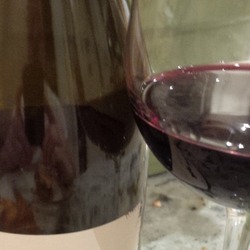
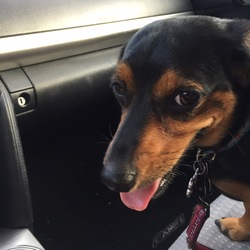





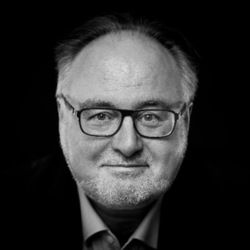

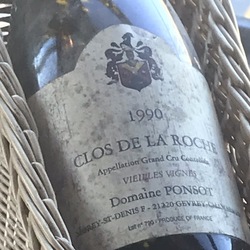


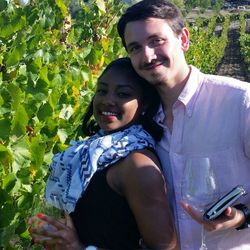
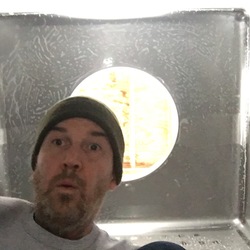
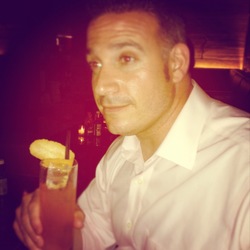
Aaron Rankin
PnP at cellar temp. Striking lightness and clarity, even for a Pinot. Nose of bright cherries, sweet spices, wet stones and minerals, and something metallic underneath. Understated thus far. Palette, however, is rich and lively with well integrated acid that uplifts flavors reminiscent of the nose. Light structure but holding it all together. An hour open brings out great depth of fruit, 5 spice, and something savory I can’t identify. Simply beautiful. Time to re-up my Peay bottle stock. — 6 years ago